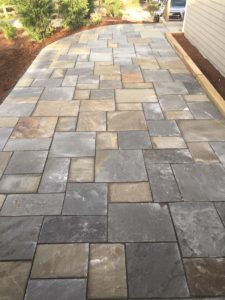The question: I’d love to create a patio in my yard. Can I do it myself?
While you can do some of the work toward putting in a patio, you’re going to need professional help with at least part of the job. That’s because the most important factor in installing a good patio that will last for years is preparing a good base — which is done with heavy equipment.
Before that happens, a first step is to assess your yard. Where will you put the patio? Look for a level area that’s easy to access — you want to make sure an excavator can get in to prep the site. It’s important to compact the earth heavily. Otherwise the ground will settle in a few years and the patio will be uneven, creating a safety hazard for you and your guests.

Another place you can invest in some advance work is in choosing materials. With all the natural and synthetic materials available, it can be a little overwhelming. Popular choices include natural stone, concrete pavers, brick, flagstone, and porcelain tile.
Natural stone is one of the most expensive options, but it keeps the same color forever and is very durable. Manufactured pavers and bricks are easier to install than stone, though concrete pavers do show wear: you will notice aggregate after 10 years. Porcelain tile has become a top choice because it’s supposed to last forever, and it should maintain its color through the years, even in harsh elements. Fairly new to the market, granite from overseas will, like all natural stone, resist wear. Just keep in mind that any natural product will have irregularities.
I like concrete pavers — they’re easy to install and they look good. You can fit pavers together tightly. The larger joints in bluestone slabs will require more maintenance, as weeds will inevitably grow between the joints.
Once you’ve chosen a material, you’ll need to decide on a design. Often, the material you choose will determine the pattern. With natural bluestone, for instance, you will always have a random pattern because the stones are all different sizes and shapes. With bricks or pavers, you can get more creative, but keep in mind that more labor-intensive patterns will also be more expensive. Herringbone patterns are a favorite choice, but creating them involves a lot of cutting and waste.
As for accessorizing your patio, lots of people like to put in fire pits. You’ll need to check the rules in your town and see what paperwork you’ll need for approval. A portable propane fire pit is less of a hassle. And there are other permanent structures that can be really nice to have, like a sitting wall or an outdoor kitchen.
With good plans, after a couple of days of preparation, most patios can be laid down in one day. That’s one of the things that’s most satisfying about putting in a patio — it’s a big change that can come together quickly.
This week’s Dovetail Joint question is answered by Ethan Poulin, owner of Ethan Poulin Landscaping in Truro. Keep sending your questions and we’ll find more good answers.
